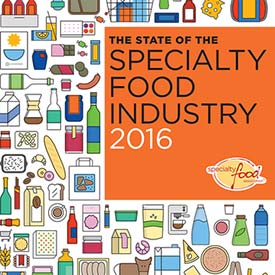The specialty food industry continues to be a bright spot in the United States economy and is now a $120.5 billion-dollar industry, largely fueled by the growth of small businesses. Specialty food sales at retail reached $94 billion in 2015, a 19.7 percent jump since 2013, driven by product innovations and wider availability of specialty foods through mass-market outlets.
Sales through foodservice outlets grew at a faster clip – 27 percent to hit $26.5 billion – as diners continue to make specialty food a part of away-from-home meal purchases. The supply chain has also embraced the importance of e-commerce as a way to appeal directly to consumers. Eighty-five percent of manufacturers sell via their own website and 49 percent use a third-party platform like Amazon. Importers cite online sales as one of their fastest growing channels.
 These findings are from a new report issued by the Specialty Food Association that was produced in conjunction with research firms Mintel International and SPINS/IRI. Entitled The State of the Specialty Food Industry 2016, it tracks US sales of specialty food through supermarkets, natural food stores and specialty food retailer outlets.
These findings are from a new report issued by the Specialty Food Association that was produced in conjunction with research firms Mintel International and SPINS/IRI. Entitled The State of the Specialty Food Industry 2016, it tracks US sales of specialty food through supermarkets, natural food stores and specialty food retailer outlets.
The 10 best selling categories in the industry are similar to last year. Cheese and cheese alternatives remains at the top, growing by 14.7 percent over the past two years. Frozen and refrigerated meat, poultry scored a 23.1 percent growth rate, followed by a 22.3 percent gain for chips, pretzels, and snacks.
Refrigerated entrees and prepared meals joined the top 10 after experiencing a 34.5 percent sales increase over a two-year period. Categories with the biggest sales growth are refrigerated RTD tea and coffee; eggs; and jerky and other meat snacks. Unit sales of specialty foods grew 13.7 percent overall to 15.6 billion.
“American consumers continue to move toward specialty foods and away from mass,” says Ron Tanner, vice president of philanthropy, government and industry relations for the Specialty Food Association. “Consumers are looking for foods with fewer and cleaner ingredients, and products that are made by companies with values they care about. All of these define specialty food.”
Many in the supply chain believe non-GMO will be a product claim of growing importance to consumers, with 49 percent of manufacturers planning to introduce items that are non-GMO in 2016. Local products also continue to remain an important way retailers differentiate their offerings.
Highlights of the report, plus a larger summary with charts and data, can be found at specialtyfood.com/stateindustry2016.
About the Specialty Food Association
The Specialty Food Association works on behalf of food artisans, importers and entrepreneurs. Established in 1952 in New York City, the not-for-profit trade group provides more than 3,300 members in the USA and abroad with resources, knowledge and connections to promote their companies in the marketplace. The Association owns and produces the Winter and Summer Fancy Food Shows, and presents the sofi™ Awards honoring excellence in specialty food.





